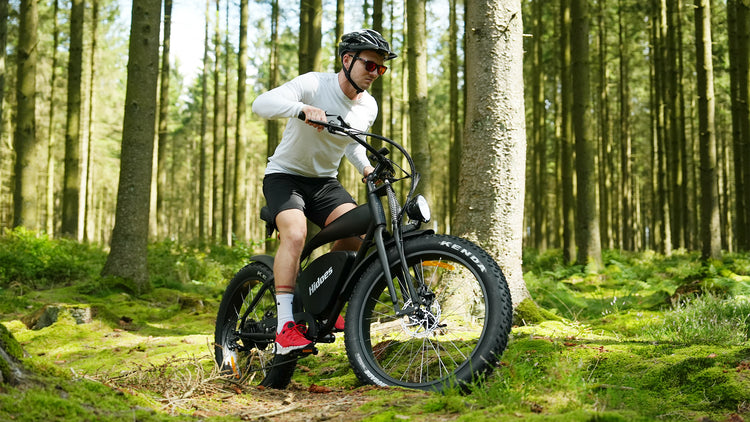
The rise of electric bikes has revolutionized the cycling world, offering a convenient and enjoyable way to tackle various terrains and distances. Among the many types of e-bikes available, fat tire electric bikes have garnered significant attention for their unique design and capabilities. But the question on many potential riders' minds is, are fat tire electric bikes suitable for heavy riders? This article aims to provide a detailed examination of the features, benefits, and considerations of fat tire e-bikes for those with a heavier build.
Understanding Fat Tire Electric Bikes
Fat tire e-bikes are characterized by their large, wide tires, typically measuring between 4 to 5 inches in width. These bikes are designed to provide superior traction and stability on a variety of surfaces, including sand, snow, gravel, and muddy paths. The increased contact area of the tires allows for better weight distribution, enhancing the bike's ability to handle heavy loads.
Weight Capacity and Frame Design
One of the primary concerns for heavy adults is whether an e-bike can support their weight. Fat tire e-bikes are often built with robust frames, typically made from sturdy materials like aluminum or steel, which can handle significant weight loads. Many models are designed to support riders up to 300 pounds or more, making them an excellent option for heavy riders. It's crucial to check the manufacturer's specifications for the maximum weight capacity to ensure the bike can safely accommodate your needs. Hidoes fat tire ebike payload are more than 330 lbs.Advantages for Heavy Riders
1. Enhanced Comfort: The wide tires on fat tire e-bikes distribute the rider's weight more evenly, reducing pressure points and providing a smoother, more comfortable ride. This is particularly beneficial for heavier riders who may experience more discomfort on narrower tires.
2. Improved Traction: The large contact area of fat tires offers better grip on uneven or slippery surfaces, enhancing stability and control. This is especially important for heavy duty, as a loss of traction can lead to instability and potential accidents.
3. Greater Stability: The low center of gravity provided by the fat tires makes the bike more stable, which is crucial for maintaining balance and control during cornering or when navigating obstacles.
4. Cushioned Ride: The air-filled tires on fat tire e-bikes act as a natural suspension, absorbing shocks and bumps from the terrain. This results in a more comfortable ride, reducing the impact on the rider's body, particularly beneficial for those with a heavier build.
Considerations for Heavy Riders
While fat tire e-bikes offer numerous advantages, there are a few considerations to keep in mind:
1. Motor Power: Heavier riders may require a more powerful motor to achieve the same level of performance as lighter riders. Look for e-bikes with high-wattage motors to ensure adequate power for climbing hills and maintaining speed.
2. Battery Life: The battery life of an e-bike can be affected by the rider's weight. Heavier riders may find that they need to recharge their e-bike more frequently to cover the same distances as lighter riders.
3. Portability: Fat tire e-bikes are generally heavier and bulkier than other e-bike models, which may make them more challenging to lift or transport. Consider a model with a folding frame or lightweight design if portability is a concern.
FAQs
Q1: What is the ideal weight limit for a fat tire electric bike designed for heavy riders?
A1: The ideal weight limit varies depending on the specific model and manufacturer. However, many fat tire e-bikes are designed to support riders up to 300 pounds or more. Always check the manufacturer's specifications for the recommended maximum weight capacity.
Q2: Can fat tire electric bikes handle off-road terrain?
A2: Yes, one of the primary advantages of fat tire e-bikes is their excellent performance on off-road terrain, including sand, snow, and muddy paths. The wide tires provide better traction and stability on uneven surfaces.
Q3: How does the weight of the rider affect the battery life of an e-bike?
A3: The weight of the rider can impact the battery life, as heavier riders may require more energy to maintain the same speed and performance. This could result in more frequent recharging.
Q4: Are fat tire electric bikes difficult to transport?
A4: Due to their larger size and weight, fat tire e-bikes can be more challenging to transport compared to other e-bike models. However, some models offer folding frames or lightweight designs to make transportation more manageable.
Q5: What motor power is recommended for heavy riders?
A5: For heavy riders, it's recommended to look for e-bikes with high-wattage motors (500W or higher) to ensure sufficient power for climbing hills and maintaining speed. Hidoes fat tire ebikes motor are 1200W.
In conclusion, fat tire electric bikes can be an excellent choice for heavy riders, offering enhanced comfort, stability, and control. By considering the factors discussed above and addressing the FAQs, potential riders can make an informed decision about whether a fat tire e-bike is the right fit for their needs. Always prioritize safety, comfort, and performance when selecting the perfect e-bike for your weight and riding preferences.








